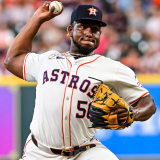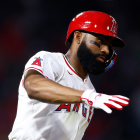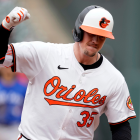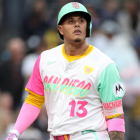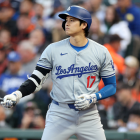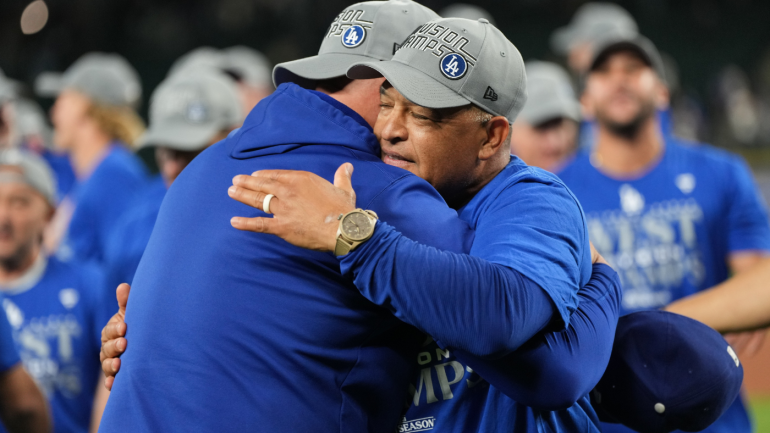
In what was expected to be a "step back" season as they incorporated more youth into the lineup, the Los Angeles Dodgers again have one of the best records in baseball. The Dodgers on Saturday night clinched the NL West with their win over the Mariners. Los Angeles has now won 10 division titles in 11 years.
The Dodgers have been led this year by the truly dynamic duo of Mookie Betts and Freddie Freeman, who bat 1-2 atop the lineup and figure to finish alongside Atlanta Braves star Ronald Acuña Jr. in the top three of the NL MVP voting, in whatever order. Betts leads all position players in WAR and Freeman recently set the franchise doubles record with a chance to hit 60 this year.
As good as they've been this season, the Dodgers have very real concerns heading into the postseason, particularly with their rotation. Clayton Kershaw is not 100% physically, Lance Lynn leads MLB in home runs allowed and rookie Bobby Miller has already set a new career high in innings. This is not the formidable Dodgers rotation they typically boast in October.
Because of the rotation concerns, Los Angeles figures to lean on their offense and bullpen in the postseason. I mean, every team will lean on every part of its roster in the postseason, but Dodgers will need the offense and bullpen to pick up the slack. The rotation is in a diminished state due to injuries and ineffectiveness. Other parts of the roster will have to compensate.
It goes without saying Betts and Freeman will have to continue their MVP-caliber performances for the Dodgers to make a deep run in October. It's very difficult to make noise in the postseason without your best players being your best players. Here are three other things that need to happen for the Dodgers to have their best chance at capturing their second World Series title in four years.
1. Smith gets back on track
For the first three months of the season, catcher Will Smith was every bit as good as Betts and Freeman. He was performing at an MVP-caliber level and he earned his first All-Star Game selection. Smith's play leveled at midseason and has since slipped farther. His numbers since the All-Star break are not especially good (stats through Friday night):
| PA | AVG/OBP/SLG | OPS+ | HR | RBI | |
|---|---|---|---|---|---|
First half | 288 | .279/.396/.494 | 144 | 13 | 46 |
Second half | 220 | .253/.327/.392 | 95 | 5 | 25 |
To be clear, Smith hasn't been bad in the second half, he's just been well south of his first-half performance. And Smith is not alone here, either. To be fair, many catchers perform worse in the second half because the position is so physically demanding. Catchers are beat up and bruised, and their hands all ache after so many of months behind the plate. It is a brutal position.
Still, the best version of the Dodgers has Smith performing at an All-Star level in the No. 3 lineup spot behind Betts and Freeman, and he has been something less than that since the All-Star break. Clinching early will give the Dodgers a chance to rest Smith a bit the last two weeks, and hopefully allow him to get a second wind before October. He is every bit as important to the team as Betts and Freeman, maybe even moreso when you consider the pitching-related responsibilities.
2. Martinez stays healthy
The Dodgers moved on from stalwart Justin Turner this past offseason and replaced him with J.D. Martinez at DH -- Martinez and Turner essentially traded places with Turner going to the Boston Red Sox -- and Martinez has had the desired impact. He's closing in on 30 home runs and could drive in 100 runs. Martinez is an old school RBI guy, for lack of a better term.
Nagging hamstring and groin injuries have limited Martinez lately, and although he's been very productive in September (.391/.444/.565), there is some apprehension when he runs. Martinez is taking care to not push anything with his groin and hamstring. This late in the regular season, another setback could end his 2023.
To state the obvious, the Dodgers need a healthy and productive Martinez to have their best chance at a deep postseason run. He is a middle of the order masher with postseason chops -- Martinez is a career .303/.391/.596 hitter in October -- and he fills an important role in the No. 5 spot of the lineup. The top of the lineup is stacked. It's on Martinez to drive 'em all home.
3. The platoons create matchup nightmares
An underrated part of Mookie's season is his ability to play second base (and even some shortstop). By starting more than 50 games at second base, Betts has allowed the Dodgers to play the resurgent Jason Heyward in right field. Heyward, in turn, has mashed righties all season. It's part of the club's somewhat atypical -- yet effective -- platoons.
Here's how Dodgers manager Dave Roberts has employed his platoon weapons the last few weeks:
| vs. RHP | vs. LHP | |
|---|---|---|
2B | Mookie Betts | |
LF | ||
CF | ||
RF | Jason Heyward | Mookie Betts |
Betts plays every single day, no questions asked. Heyward, Outman, and Peralta are all susceptible to left-handed pitchers though, as are Hernández, Rosario, and Taylor to right-handed pitchers. So, Roberts uses Mookie's flexibility to essentially platoon Rosario (an infielder) with Heyward (an outfielder), and put those two players in the best position to succeed.
The top of the Dodgers lineup is Betts, Freeman, Smith, Max Muncy and Martinez in that order just about every single game. The 6-9 spots are much less settled, though not in a bad way. The Dodgers use platoons very well and have more good players than lineup spots. It takes more than Betts and Freeman to have one of the highest scoring offenses in baseball. Los Angeles has enviable lineup depth, and the platoon bats to make matching up a challenge for the opposing manager in October.








